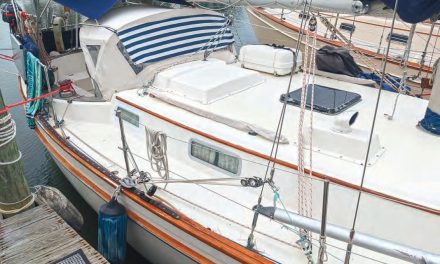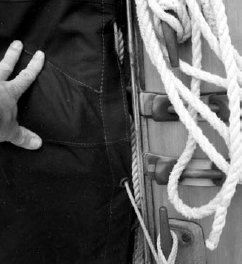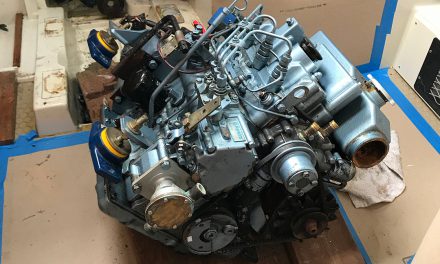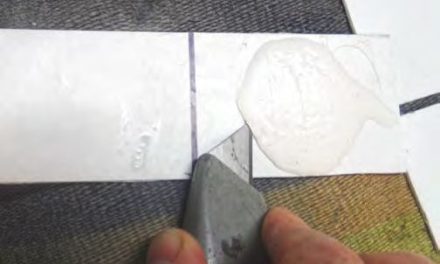A backup battery system for a fixed-mount VHF ensures communications in an emergency.
Despite the introduction of satellite communications and cell phones over the past couple of decades, the humble, old-school VHF radio remains the the primary, most reliable emergency communications tool for inshore sailors. And this means the VHF radio needs to work, especially during emergencies. One area of vulnerability for fixed-mount radios is their power source, the ship’s batteries.

My fixed-mount VHF is mounted in a cabinet at the chart table. I have separate positive and negative bus bars for other electronics at this location, each with its own fuse. Because a VHF radio does not require much current, a backup battery intended to provide emergency power can be small. I selected a UB1270 sealed, maintenance-free, 12-volt, lead acid battery with a 7 amp-hour capacity. It’s about the same size as a desktop tape dispenser and has spade connectors. Because this battery is commonly used for emergency exit lighting and electric trailer brake backup systems, it’s inexpensive and widely available.

Of course, a battery alone wasn’t going to solve my problem. I needed a way to keep the backup battery charged, and a quick and easy way to switch over to backup power as needed. To accomplish both goals I purchased a single-throw, double-pole switch and a 3-amp diode.

First, I fabricated a mounting bracket for the switch from scrap aluminum. To fix the switch in the normal ship’s battery position, I installed a spring-loaded switch guard that keeps a two-position toggle switch safely locked in one position, as needed. (These are available through McMaster-Carr, where I purchased the switch, but they are a bit pricey. I happened to find one at a car show swap meet for a dollar or two.)

Connecting all of the parts to make the system was straightforward. I disconnected the positive wire connecting the VHF to the house bank’s positive bus bar. I reconnected this wire to the center position of the switch. Next I wired the house bank positive and the backup battery positive to opposite ends of the switch.

Then I connected the 3-amp diode to bridge these two battery positive wires at the switch. By doing this, I’m ensuring a constant (without regard to the switch position) one-way current flow from the house bank to the backup battery to maintain the backup battery charge state. To complete the wiring, I simply connected the backup battery negative to the local negative bus bar. The VHF negative remained unchanged.

After tidying up the wires, I checked to confirm proper operation and was able to broadcast and receive transmissions, regardless of which battery the radio was connected to. Now, come hell or high water, I’ll be able to use the VHF to seek help.
Another Approach to Redundancy – Editors
John Churchill offers an excellent, practical solution to provide backup power for fixed-mount VHF redundancy. Another approach is a handheld VHF radio, which, if kept charged, operates independent of a ship’s battery bank. But a handheld VHF has its own glaring limitation: reduced transmission range. This isn’t a product of the radio or its power, but rather a result of the inferior antenna, compared to the masthead antenna the fixed-mount VHF uses. One solution to the handheld VHF transmission problem is to unscrew the antenna and replace it with a SMA-to-BNC adaptor. This adaptor allows the handheld radio to be connected to the ship’s mast-mounted antenna, thus solving the range problem in an emergency. These adaptors are available from most handheld VHF radio manufacturers, including Standard Horizon and ICOM.
Diodes – David Lynn, Electronics Editor
The primary function of a diode is to restrict the flow of current in a circuit to one direction. Diodes have two terminals, the anode and the cathode. When the voltage on the anode side of the circuit is a few tenths of a volt higher than on the cathode side, then current flows. As soon as the voltage on the cathode side is more positive than the anode side, the diode blocks further current flow. In John’s circuit, the diode keeps the backup battery charged by allowing current to flow from the house battery bank, while preventing the backup battery from discharging back into the house batteries when they are low or, perish the thought, shorted by seawater.
There are two caveats regarding this circuit. First, the diode must be able to handle the maximum current that will pass through it. The 3-amp diode that John chose will handle most situations, but it would not hurt to go bigger. Should the house batteries get down to 12.2 volts, for example, and John is using the VHF heavily, the backup battery could drop well below 12 volts. If he then started his engine and continued using the VHF, the large charge current from the alternator plus a portion of the 6 amps or so the radio requires when transmitting would flow through the diode, quite likely smoking it. Second, the battery should be fused. If the switch is set so that the radio is powered by the house battery bank and a short occurs in that circuit, the large current flowing from the house batteries would destroy the switch and possibly melt the wiring.






